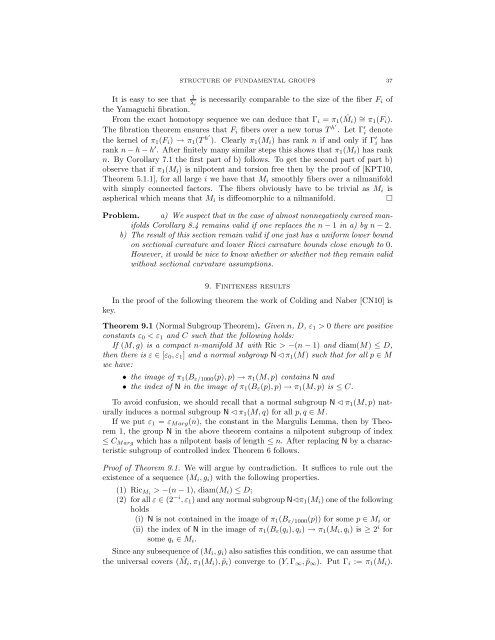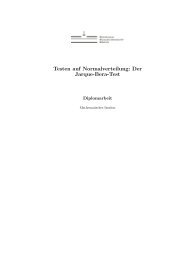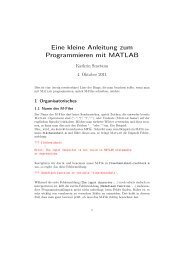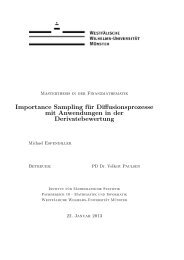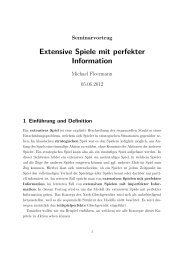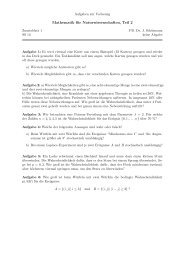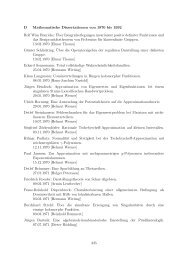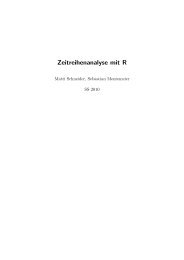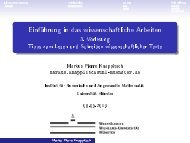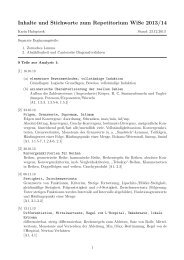Margulis Lemma
Margulis Lemma
Margulis Lemma
You also want an ePaper? Increase the reach of your titles
YUMPU automatically turns print PDFs into web optimized ePapers that Google loves.
STRUCTURE OF FUNDAMENTAL GROUPS 37<br />
It is easy to see that 1 λ i<br />
is necessarily comparable to the size of the fiber F i of<br />
the Yamaguchi fibration.<br />
From the exact homotopy sequence we can deduce that Γ i = π 1 ( ˆM i ) ∼ = π 1 (F i ).<br />
The fibration theorem ensures that F i fibers over a new torus T h′ . Let Γ ′ i denote<br />
the kernel of π 1 (F i ) → π 1 (T h′ ). Clearly π 1 (M i ) has rank n if and only if Γ ′ i has<br />
rank n − h − h ′ . After finitely many similar steps this shows that π 1 (M i ) has rank<br />
n. By Corollary 7.1 the first part of b) follows. To get the second part of part b)<br />
observe that if π 1 (M i ) is nilpotent and torsion free then by the proof of [KPT10,<br />
Theorem 5.1.1], for all large i we have that M i smoothly fibers over a nilmanifold<br />
with simply connected factors. The fibers obviously have to be trivial as M i is<br />
aspherical which means that M i is diffeomorphic to a nilmanifold.<br />
□<br />
Problem. a) We suspect that in the case of almost nonnegatively curved manifolds<br />
Corollary 8.4 remains valid if one replaces the n − 1 in a) by n − 2.<br />
b) The result of this section remain valid if one just has a uniform lower bound<br />
on sectional curvature and lower Ricci curvature bounds close enough to 0.<br />
However, it would be nice to know whether or whether not they remain valid<br />
without sectional curvature assumptions.<br />
9. Finiteness results<br />
In the proof of the following theorem the work of Colding and Naber [CN10] is<br />
key.<br />
Theorem 9.1 (Normal Subgroup Theorem). Given n, D, ε 1 > 0 there are positive<br />
constants ε 0 < ε 1 and C such that the following holds:<br />
If (M, g) is a compact n-manifold M with Ric > −(n − 1) and diam(M) ≤ D,<br />
then there is ε ∈ [ε 0 , ε 1 ] and a normal subgroup N ⊳ π 1 (M) such that for all p ∈ M<br />
we have:<br />
• the image of π 1 (B ε/1000 (p), p) → π 1 (M, p) contains N and<br />
• the index of N in the image of π 1 (B ε (p), p) → π 1 (M, p) is ≤ C.<br />
To avoid confusion, we should recall that a normal subgroup N ⊳ π 1 (M, p) naturally<br />
induces a normal subgroup N ⊳ π 1 (M, q) for all p, q ∈ M.<br />
If we put ε 1 = ε Marg (n), the constant in the <strong>Margulis</strong> <strong>Lemma</strong>, then by Theorem<br />
1, the group N in the above theorem contains a nilpotent subgroup of index<br />
≤ C Marg which has a nilpotent basis of length ≤ n. After replacing N by a characteristic<br />
subgroup of controlled index Theorem 6 follows.<br />
Proof of Theorem 9.1. We will argue by contradiction. It suffices to rule out the<br />
existence of a sequence (M i , g i ) with the following properties.<br />
(1) Ric Mi > −(n − 1), diam(M i ) ≤ D;<br />
(2) for all ε ∈ (2 −i , ε 1 ) and any normal subgroup N⊳π 1 (M i ) one of the following<br />
holds<br />
(i) N is not contained in the image of π 1 (B ε/1000 (p)) for some p ∈ M i or<br />
(ii) the index of N in the image of π 1 (B ε (q i ), q i ) → π 1 (M i , q i ) is ≥ 2 i for<br />
some q i ∈ M i .<br />
Since any subsequence of (M i , g i ) also satisfies this condition, we can assume that<br />
the universal covers ( ˜M i , π 1 (M i ), ˜p i ) converge to (Y, Γ ∞ , ˜p ∞ ). Put Γ i := π 1 (M i ).


